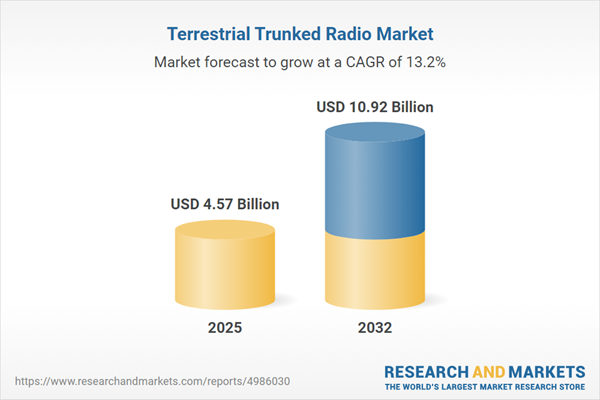Speak directly to the analyst to clarify any post sales queries you may have.
The terrestrial trunked radio market is becoming increasingly vital as organizations seek secure, robust communications to support critical operations and ensure regulatory compliance. Senior leaders recognize terrestrial trunked radio as a foundational investment for safety and operational reliability.
Market Snapshot: Terrestrial Trunked Radio Solutions
The global terrestrial trunked radio market is expanding as enterprises upgrade outdated analog systems to advanced digital solutions. Factors driving this shift include heightened awareness of network security, escalating operational complexity, and the rising demand for real-time communication capabilities. Public safety organizations and commercial enterprises are turning to resilient platforms that guarantee dependable connectivity and effective collaboration among dispersed teams. Adoption is accelerating due to a combination of narrowband reliability and the incorporation of broadband functionalities. In a dynamic regulatory landscape, evolving compliance requirements and growing operational needs drive the urgent modernization and deployment of terrestrial trunked radio systems across varied industries and geographies.
Scope & Segmentation of the Terrestrial Trunked Radio Market
This report provides targeted communications market intelligence to guide technology investments in sectors where rapid, secure information exchange is essential for daily function. The analysis addresses key dimensions of the terrestrial trunked radio ecosystem:
- Products: Base stations, gateways, handheld radios, vehicle-mounted units, and repeater equipment are integral for establishing mission-critical communications and maintaining operational reliability.
- Components: Core hardware infrastructure, secure management software, protected terminal devices, communication-specific applications, and technical service support are included, enabling robust and compliant communications environments.
- Frequency Bands: Platforms operate within the 380–400 MHz, 410–430 MHz, and 450–470 MHz bands to facilitate interoperability and reliable service across diverse regions and regulatory frameworks.
- Applications: Functionalities span secure voice and text channels, precise GPS-based tracking, and fast data transfer, equipping organizations to enhance field response and situational awareness.
- End Use Industries: The technology is deployed in defense, emergency services, transportation, utilities, and commercial settings, all of which depend on trusted and compliant communications networks to reduce operational risks.
- Regions: The report covers the Americas, Europe, Asia-Pacific, and the Middle East & Africa, each with distinct drivers for adoption and infrastructure investment shaped by regional regulations and technology readiness.
- Key Companies: Sector leaders profiled include Motorola Solutions, Hytera Communications, Airbus SE, Thales Group, Leonardo S.p.A., TETRA RADIO SYSTEMS, Abdul Rahman Al Shareef Group, ErvoCom AG, Telecommunications Consultants India Limited, and Sepura Limited, delving into strategies for innovation and supply chain reliability.
Key Takeaways for Senior Decision-Makers
- Deploying terrestrial trunked radio platforms with advanced encryption and integrated real-time GPS capabilities increases visibility, streamlines coordination, and safeguards personnel operating in spread-out locations.
- Utilizing modular and interoperable system architectures, with centralized or cloud-managed control, gives organizations scalable flexibility to adjust to evolving operational requirements and integration needs.
- Embedding LTE, 5G, and IoT interfaces within terrestrial trunked radio systems elevates secure data handling and responsiveness, crucial for handling rapidly shifting field situations and emergency events.
- Open and scalable frameworks facilitate seamless technology upgrades, supporting compliance and reducing downtime during transitions or expansions.
- Consistently applying standardized communication technology simplifies network oversight and allows more effective resource deployment across complex, multi-site organizations.
- Establishing strong, ongoing cybersecurity measures is essential to mitigate a growing array of digital threats targeting communication infrastructure.
Tariff Impact: Supply Chain and Deployment Strategies
Recent U.S. tariffs introduced for radio components have prompted organizations to reassess supply chains and deployment practices. Many businesses are strengthening supplier partnerships, directing investments toward domestic production alternatives, and favoring modular equipment to remain agile under changing legal and economic conditions. Leasing communications hardware is growing in popularity, offering resilience and cost control when faced with unpredictable financial and regulatory developments. Additionally, active engagement with relevant industry associations equips organizations to proactively monitor and respond to turbulent global supply chain trends.
Methodology & Data Sources
This report leverages detailed executive interviews from public safety, defense, and critical infrastructure, coupled with in-depth secondary research. Expert interpretation anchors the analysis, providing an impartial assessment of the challenges and priorities shaping enterprise strategy.
Why This Report Matters
- Informs investment planning to ensure operational efficiency and regulatory alignment in intensely governed sectors.
- Offers a structured approach for selecting suppliers and planning network infrastructure, mitigating the risks associated with procurement in changing markets.
- Delivers actionable, scenario-based insights that help organizations strengthen business continuity amid evolving technology and regulation.
Conclusion
Terrestrial trunked radio solutions continue to be a core asset for organizations focused on resilient, secure communications and operational continuity. This report provides a toolkit for informed procurement and technology decisions in a complex communications landscape.
Additional Product Information:
- Purchase of this report includes 1 year online access with quarterly updates.
- This report can be updated on request. Please contact our Customer Experience team using the Ask a Question widget on our website.
Table of Contents
3. Executive Summary
4. Market Overview
7. Cumulative Impact of Artificial Intelligence 2025
Companies Mentioned
The companies profiled in this Terrestrial Trunked Radio market report include:- Motorola Solutions, Inc.
- Hytera Communications Corporation Limited
- Airbus SE
- Thales Group
- Leonardo S.p.A
- TETRA RADIO SYSTEMS
- Abdul Rahman Al Shareef Group
- ErvoCom AG
- Telecommunications consultants India Limited
- Sepura Limited
Table Information
| Report Attribute | Details |
|---|---|
| No. of Pages | 197 |
| Published | October 2025 |
| Forecast Period | 2025 - 2032 |
| Estimated Market Value ( USD | $ 4.57 Billion |
| Forecasted Market Value ( USD | $ 10.92 Billion |
| Compound Annual Growth Rate | 13.2% |
| Regions Covered | Global |
| No. of Companies Mentioned | 11 |









